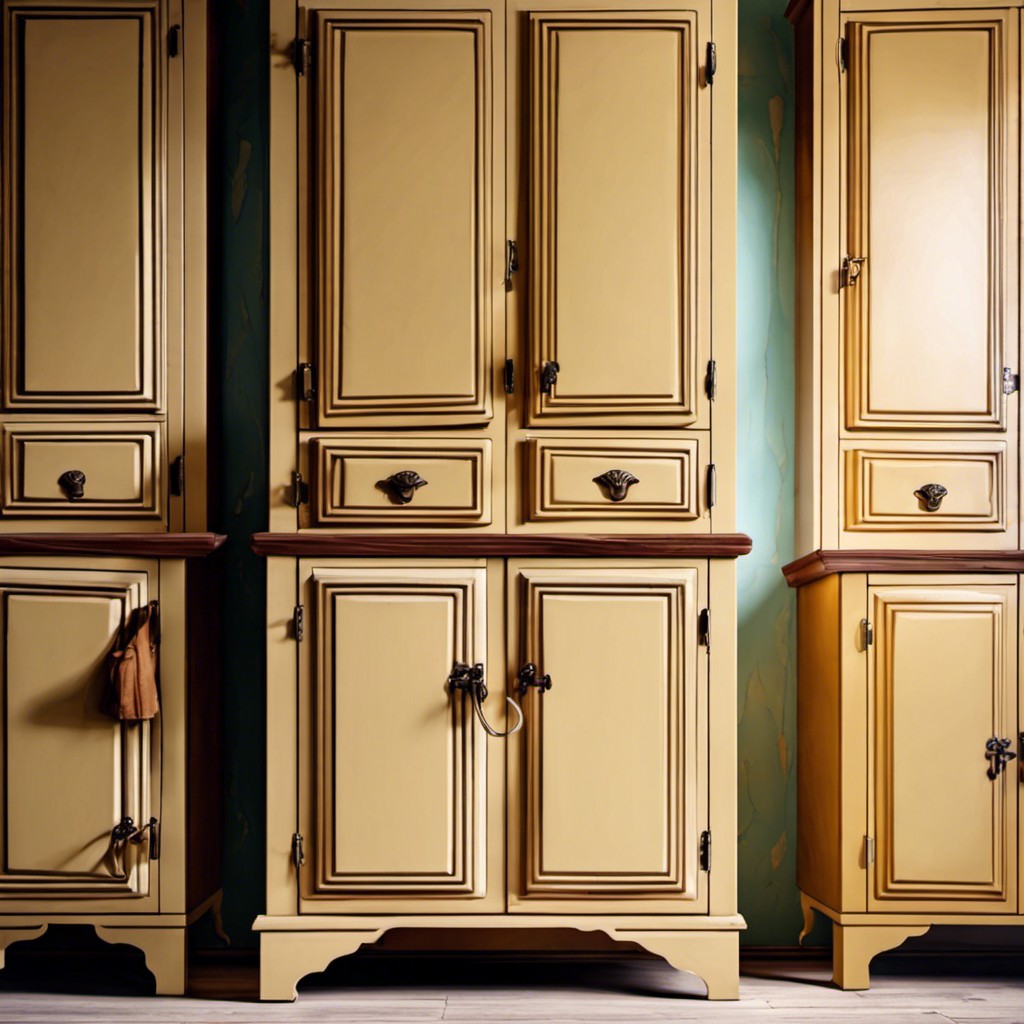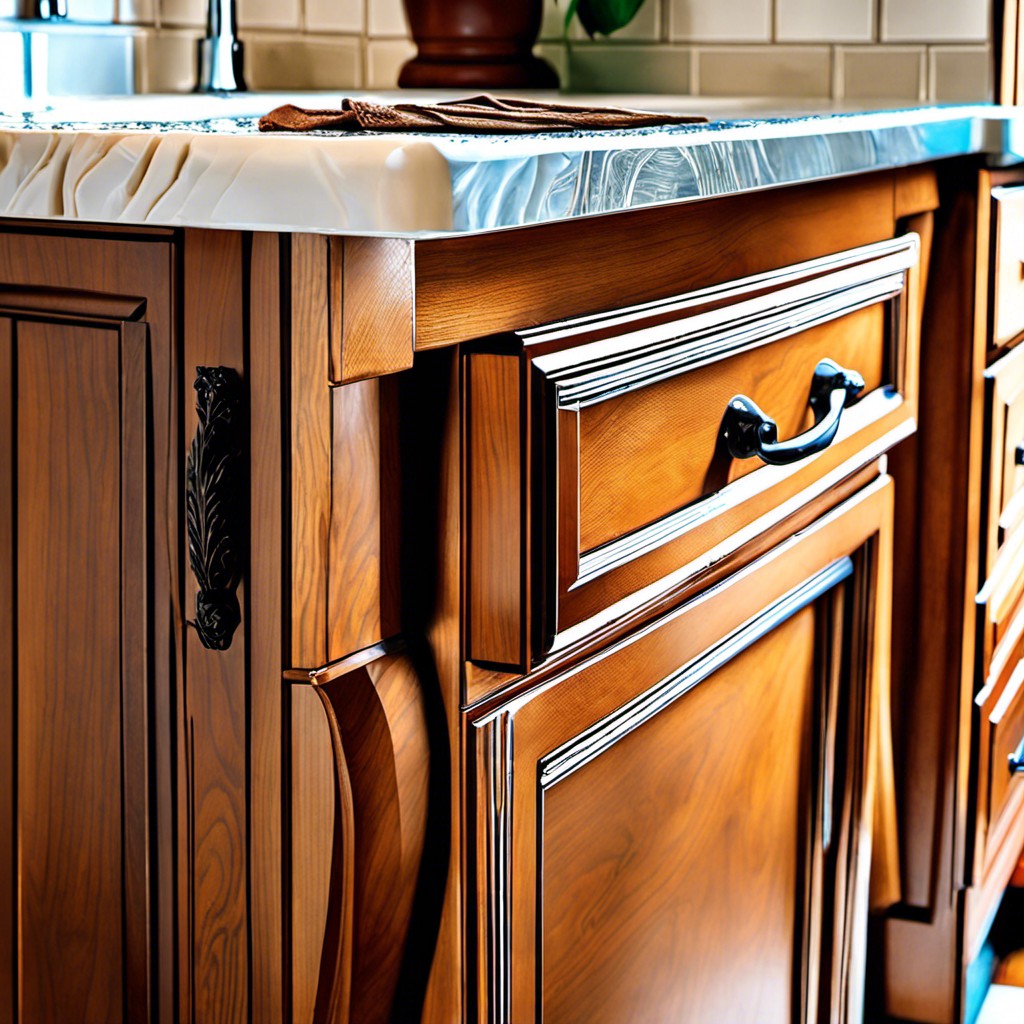Last updated on
Because everyone can accidentally spill latex paint on their wood cabinets while renovating, this article offers foolproof steps to effectively and safely remove those unwelcome splatters.
Removing latex paint from wood cabinets can be a daunting task, but with the right approach, it’s absolutely achievable. The secret lies in using the appropriate materials and following a systematic procedure.
This article provides a step-by-step guide on how to tackle this task effectively, detailing everything from the tools you’ll need, to the methods of safely and efficiently removing the paint, and finally, restoring your cabinets to their original glory.
You’ll find comprehensive instructions that cater to all levels of DIY expertise, ensuring a successful outcome for your project.
Key takeaways:
- Identify the type of latex paint on wood cabinets: acrylic or vinyl.
- Gather the necessary materials: paint scraper, sandpaper, soft cloth, mild detergent, paint thinner, gloves, safety goggles, drop cloth.
- Follow safety precautions: wear protective gear, work in a well-ventilated area, avoid flammable substances, have a first aid kit, dispose of waste properly, keep children and pets away.
- Use a step-by-step guide to remove latex paint: apply chemical paint stripper, scrape off the paint, repeat if necessary, wipe with a damp cloth.
- Restore the wood cabinets after paint removal: sand gently, condition the wood, re-stain if needed, apply a sealant, replace hardware.
- Maintain and care for wood cabinets: clean regularly, dust, use coasters and mats, avoid direct sunlight, clean spills promptly, periodically polish, repair minor damage.
Table of Contents
Identifying Type of Latex Paint On Wood Cabinets

There are predominantly two types of latex paint: acrylic and vinyl.
Acrylic is water-based and quite durable, generally used on surfaces like kitchen cabinets that require easy to clean yet sturdy coatings.
Vinyl paint is more pliable but less resilient, typically utilized for in outdoor projects.
In order to gain a fuller understanding of the kind of latex paint adorned on your wood cabinets, inspect the surface carefully.
More often than not, acrylic paint will have a glossier finish and feel harder to touch.
Alternatively, consulting the previous homeowner or conducting a quick test with a dab of denatured alcohol on an inconspicuous area might help.
If the paint comes off easily, it is likely to be an acrylic latex paint.
Materials Needed for Removing Latex Paint From Wood Cabinets

To ensure a successful removal process, equip yourself with the following tools:
- Paint Scraper: Thin-bladed and firm, a paint scraper will peel off most of the latex paint layers without damaging the wood underneath.
- Fine-Grained Sandpaper: This will help remove residual paint and smooth out any rough spots.
- Soft Cloth: For wiping down surfaces and cleaning up residual dust and paint particles.
- Mild Detergent or Soap: To clean the surface prior to paint removal.
- Paint Thinner or Chemical Stripper: Useful for stubborn paint spots. Always ensure it’s safe for wood surfaces.
- Rubber Gloves and Safety Goggles: For protection against chemicals.
- Drop Cloth or Newspapers: To protect your floor from the paint scrapings and possible spillages.
Having all your equipment on hand will help make this task easier and more importantly, safer. Each of these tools has its own role, from initial cleaning to final restoration, ensuring that your cabinets are spotless and ready for a fresh, new look.
Safety Precautions When Removing Latex Paint From Wood Cabinets
Before diving into the removal process, it’s vital to take necessary precautions as safety should never be compromised.
1. Protective Wear: Don full-length clothes, use safety glasses, rubber gloves and a face mask to shield your body, eyes, and lungs from the chemical paint removers.
2. Ventilation: The paint stripper’s fumes can be hazardous. Work in a well-ventilated room or outdoor area to ensure proper airflow.
3. Flammable Substances: Some paint removers are flammable. Make sure to keep them away from open flames, spark-prone areas, and direct sunlight.
4. First Aid: Keep a first aid kit nearby in case of accidental exposure to chemical solvents. If any chemical comes into contact with your skin or eyes, rinse it off immediately with water.
5. Waste Disposal: Dispose off used materials correctly as per the local waste disposal regulations to prevent possible pollution. Never pour paint stripper down drains.
6. Child and Pet Safety: Ensure that your pets and children stay away from the work area until you have completely finished and cleaned up.
Always remember to adhere to these precautions, as prioritizing safety will make the task smoother and free from unwanted circumstances.
Step-by-Step Guide to Removing Latex Paint From Wood Cabinets
Begin with ensuring that the work area is well-ventilated. Lay down a protective sheet beneath the cabinets to catch any drips and safeguard your floors. Always remember to use rubber gloves for hand protection.
Start by applying a generous layer of chemical paint stripper to a small test area on the cabinet. Paint strippers are effective at softening and lifting up the paint, making the removal process easier.
Allow the stripper to sit according to manufacturer’s instructions; typically 15 to 30 minutes. You’ll notice the paint beginning to bubble up – this indicates that it’s ready to be scraped off.
Use a plastic scraper to gently remove the paint. Avoid metal scrapers as they can scratch the wood. For intricate detailing or crevices, a wire brush or toothbrush will work better. Always scrape in the direction of the wood grain for best results.
If any paint remains, reapply the stripper, then scrape again. It might take a few rounds to completely remove the paint, especially if there are multiple layers.
Finally, wipe the surface with a damp cloth to eliminate residue. If there are still traces of paint, a mild abrasive pad can be used. Note that water-based latex paint will likely come off easier than oil-based variants.
Once you’re satisfied with the results, let the surface dry thoroughly before you proceed with any refinishing.
Common Mistakes and Troubleshooting in Latex Paint Removal From Wood Cabinets
Starting without testing: Always apply your chosen removal method to a small, hidden area first to identify potential damage to the wood surface.
Over-scrubbing: This can cause unnecessary scratches or gouges in the cabinet surface. Use a soft cloth or sponge and gentle circular movements.
Skipping safety gear: Failing to protect your skin, eyes, or lungs can have serious consequences. Always make sure you’re wearing gloves, eye protection, and a mask if necessary.
Using incompatible products: Some chemicals can react with the latex paint or the wood, causing discoloration or other damage. Ensure your cleaning products are safe for both.
Ignoring dwell time: Many removal products require time to “dwell” on the paint before wiping or scrubbing away. Rushing this process may lead to ineffective results.
Trying to remove all paint at once: If the paint layer is thick, you might need to repeat the process a few times. Attempting to remove it all in one go could harm the wood underneath.
Not cleaning post-removal: Residual chemicals can harm the wood if left unattended. Rinse the cabinet surface thoroughly after all paint is removed.
If you encounter unusual difficulties, reconsider your technique. More ingrained or stubborn paint leftovers might benefit from professional-grade solvent treatments. However, avoid rushing to this heightened measure and remember the potential risks to your furniture’s condition.
Restoration Tips for Wood Cabinets After Latex Paint Removal
After successfully removing latex paint, there may be minor damage to your cabinets. Fear not, a little restoration can return the wood to its former glory.
1. Sand gently: Use fine-grit sandpaper to smooth any rough spots. Be careful not to sand too hard or you risk additional damage.
2. Condition the wood: Apply a wood conditioner to restore the natural oils lost during the paint removal process.
3. Stain if needed: If the original stain was damaged, you might want to re-stain the wood. Use a stain color that matches your cabinet’s original hue.
4. Finish with a sealant: After the stain has dried, apply a clear sealant to protect the wood from future damage. A sealant also brings out the wood’s natural beauty and adds sheen.
5. Replace hardware: If your hardware was also damaged, or simply dated, consider adding new knobs and handles. Not only it will improve functionality, but it can completely update the look of your cabinets, too.
Remember, patience ensures the best results. Do not rush any of these steps. Give the wood time to absorb the conditioner and the sealant time to dry properly. Only then will your newly revived cabinets truly shine.
Maintenance and Care for Wood Cabinets Post Latex Paint Removal
Preserving the appearance and durability of your newly cleaned cabinets can be achieved through regular maintenance and care. Here are some helpful suggestions:
1. Regular Cleaning: Use a soft cloth and mild soap to wipe down the cabinets weekly, avoiding the use of harsh chemicals that could damage the wood.
2. Dust Regularly: Dust accumulation can make cabinets look dull. Use a soft microfiber cloth or a feather duster for this task.
3. Use Coasters and Mats: To prevent moisture damage or stains, place coasters or mats under cups, dishes, and plants.
4. Avoid Direct Sunlight: Prolonged exposure may fade the wood. Use blinds or curtains to protect your cabinets.
5. Prompt Accident Cleanup: Immediate cleanup of spills or splatters helps prevent permanent staining.
6. Polish Periodically: A quality furniture polish can protect the wood and maintain its sheen.
7. Repair Minor Damage: Attend to minor scratches or chips immediately. Use a touch-up kit that matches your cabinet’s colour.
By following these tips, you can keep your cabinets looking great for years to come.
FAQ
What removes dried latex paint from wood?
Dried latex paint can be effectively removed from wood using denatured alcohol or a product such as Goof-Off.
How do you remove latex paint without removing varnish from wood?
To remove latex paint without removing varnish from wood, soften the paint by applying a few drops of olive oil, cover with a cloth to soak for an hour, then wipe it off with a rag or gently scrape off using a plastic paint scraper.
What is the fastest way to remove paint from kitchen cabinets?
The quickest method for removing paint from kitchen cabinets involves applying a thick layer of paint stripper, waiting for the paint to bubble, and then carefully scraping off the paint with a scraper, disposing of the residue safely in an old metal container.
Can household items be used to remove latex paint from wooden surfaces?
Yes, household items such as vinegar, rubbing alcohol, or dish soap can be effectively used to remove latex paint from wooden surfaces.
Will removing latex paint damage the surface of wooden cabinets?
No, removing latex paint will not damage the surface of wooden cabinets if done properly and carefully.
Is there a non-toxic method of removing latex paint from wooden kitchen cabinets?
Yes, a non-toxic method of removing latex paint from wooden kitchen cabinets is using a mixture of equal parts white vinegar, a gentle detergent, and warm water applied with a soft cloth or sponge.





